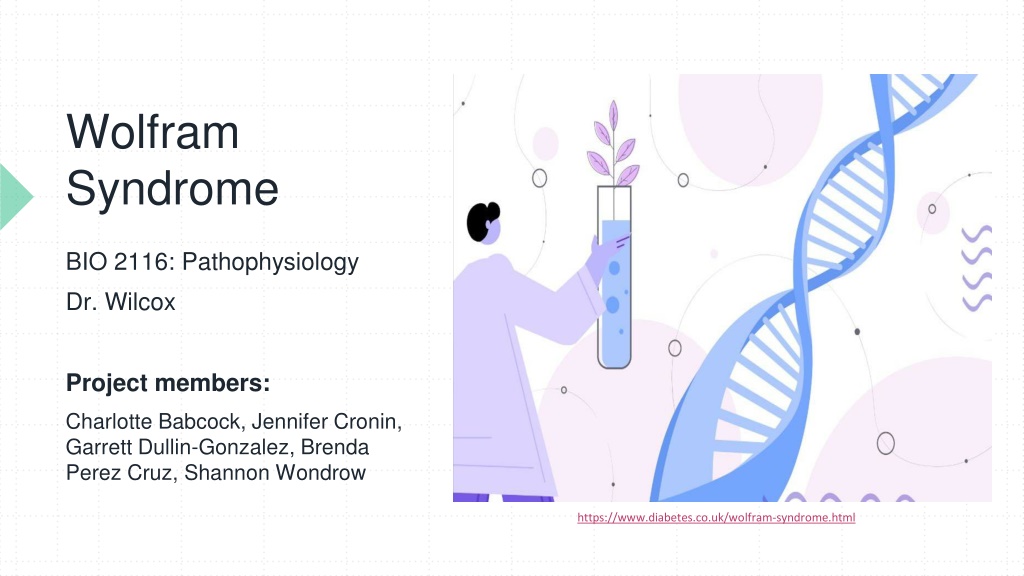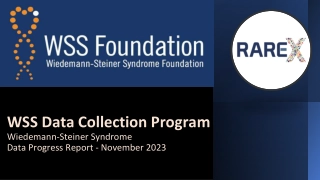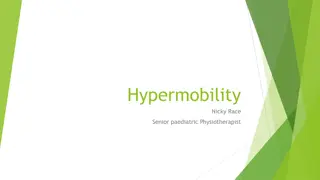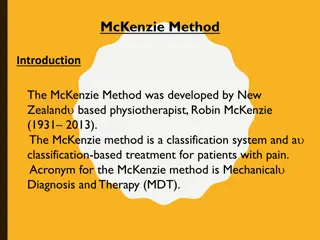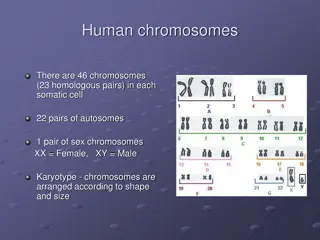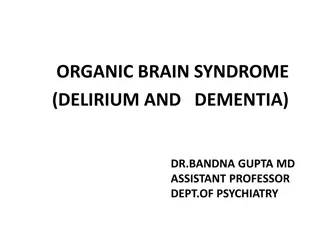Understanding Wolfram Syndrome: Symptoms and Implications
Wolfram Syndrome, also known as DIDMOAD, is a rare genetic disorder affecting about 1 in 160,000-770,000 people worldwide. It is characterized by the presence of Diabetes Insipidus, Diabetes Mellitus, Optic Atrophy, and Deafness. The primary genetic mutation in the WFS1 gene leads to various symptoms from childhood, including diabetes and optic nerve atrophy, affecting insulin production, glucose absorption, and vision. Early diagnosis and management are crucial to address the multisystem manifestations of this complex syndrome.
Download Presentation

Please find below an Image/Link to download the presentation.
The content on the website is provided AS IS for your information and personal use only. It may not be sold, licensed, or shared on other websites without obtaining consent from the author. Download presentation by click this link. If you encounter any issues during the download, it is possible that the publisher has removed the file from their server.
E N D
Presentation Transcript
Wolfram Syndrome BIO 2116: Pathophysiology Dr. Wilcox Project members: Charlotte Babcock, Jennifer Cronin, Garrett Dullin-Gonzalez, Brenda Perez Cruz, Shannon Wondrow https://www.diabetes.co.uk/wolfram-syndrome.html
The primary Wolfram Syndrome 1 (WFS1) affects gene producing wolframin; a glycoprotein Wolfram Syndrome, also referred to as DIDMOAD, is a genetic mutation that results in a missing or mutated gene in the body Diabetes Insipidus (DI), Diabetes Mellitus (DM), Optic Atrophy (OA) and Deafness (D) What is Wolfram Syndrome? DIDMOAD is an acronym related to the common symptoms of the disorder The WFS1 gene mutation causes dysfunctional protein folding, Calcium homeostasis abnormalities, Endoplasmic Reticulum (ER) stress and Mitochondria dysfunction
What is Wolfram Syndrome cont d This is a rare autosomal-recessive genetic disorder It affects about 1 in 160,000-770,000 people worldwide It was discovered in 1938 by Wolfram and Wagener Studied siblings suffering from DM and OA Ellie White:(bottom photo) a Colorado resident that is living with Wolfram syndrome more to come on her story https://kidshealth.org/en/teens/genes-genetic-disorders.html https://www.rmpbs.org/blogs/rocky-mountain-pbs/ellie-white-wolfram- syndrome/
Signs and Symptoms Many common symptoms tend to present from childhood to adolescence Age 6: (diabetes mellitus) DM WFS1 decreases -cells, lowers insulin causing diabetes Occurs in about 87% of patients Cannot absorb glucose from diet, treated with insulin therapy DM clinically diagnosed earlier with WFS1 than type 1 DM (T1DM) Not autoimmune, no antibodies present against -cells Symptoms: frequent urination, increased thirst, blurry vision, weight loss https://www.osmosis.org/learn/Endocrine_system:_Diabetes_mel litus
Signs and Symptoms cont d Age 11: Optic Atrophy (OA) WFS1 mutation causes atrophy in optic nerve Leads to progressive loss of vision Occurs in about 80% of patients Symptoms Blurry vision Loss of color vision Reduced peripheral vision https://gene.vision/knowledge-base/dominant-optic-atrophy-for- patients/
Signs and Symptoms cont d Age 13: Sensorineural hearing loss (Deafness) Genetic mutation of WFS1 causes constant damage to hair cells and auditory nerve. Common in around 65% of patients Symptoms Initially have loss of high-frequency sounds Eventually progress to low-frequency sounds Due to neuronal damage, will usually result in eventual complete deafness Progresses much quicker than most sensorineural hearing loss https://www.hearingtracker.com/hearing-loss/sensorineural- hearing-loss
Signs and Symptoms cont d Age 14: Diabetes Insipidus *central* (DI) Common in around 70% of patients Causes an issue with neural tissue in posterior pituitary responsible for ADH secretion Symptoms Large amounts of dilute urine Polydipsia Nocturia dehydration https://www.osmosis.org/learn/Diabetes_insipidus:_Nursing_Process_%28ADPI E%29
Other common signs and symptoms Urinary problems Obstruction of ureters Bladder sphincter dyssynergia More risk of bladder infections Neurological Disorder Ataxia (balance and coordination issues) Hearing loss Brain stem atrophy Chronic Fatigue Decline of physical stamina Increase of sleep https://thesnowfoundation.org/wolfram- syndrome/
Contributing Factors Wolfram Syndrome is a genetic disorder that can only be transmitted to a child by two parents that both are carriers of the WFS1 gene. This disease is classified as an autosomal recessive disorder This means that there is a 25% chance of a child getting the disease that is born of two carrier parents. https://thesnowfoundation.org/wolfram- syndrome/
Pathophysiology of Wolfram Syndrome Normally, WFS1 gene helps to regulate the homeostasis of the Endoplasmic Reticulum (ER) as well as Calcium balance in the cells and in the Mitochondria mRNA information delivered to ER where WFS1 aids in the folding of final protein product If there is an issue with the protein folding cells initiate Unfolded Protein Response (UPR) this cascade uses other regulating proteins like Activating Transcription Factor 6 (ATF6) which strengthens cells effort to properly fold proteins Another regulator, HMG-CoA reductase degradation protein 1 (Hrd1) which helps to breakdown any misfolded ER proteins in the cell. This process allows cell to remain in homeostasis https://thesnowfoundation.org/wolfram- syndrome/ **normal cell process pictured right**
Pathophysiology of Wolfram Syndrome Cont d In a patient with Wolfram syndrome, the WFS1 is defective mRNA brought to the ER has a harder time producing properly folded proteins the UPR is initiated to try and maintain homeostasis ER homeostasis is not achieved and UPR is continually activated cell produces regulators that initiate cell apoptosis, like C/EMB homologous protein (CHOP) when enough of this regulator is present, the cell initiates cell apoptosis This process is proliferated over and over again in cells in the body leading to presentation and progression of symptoms https://thesnowfoundation.org/wolfram-syndrome/
Pathophysiology Cont d Mutation of WSF1 gene located within DNA Deficiency of Ca^2+ in mitochondria causes phagocytosis, mitophagy Lowered mitochondria function lower production of ATP Dysregulated ER Ca2+ signaling Ca2+ leakage apoptosis ER stress misfolded WFS1 protein Misfolded WFS1 protein apoptosis Apoptosis neurodegeneration https://doi.org/10.1177/263300402110395 18
Diagnosis The more symptoms that develop, the more likely to test for the disorder DM and OA before the age of 16 are most common signs genetic testing usually involves testing parental DNA as well as patient DNA Confirmation of diagnosis through the sanger sequencing method (pictured right) tests for the specific gene mutation found in Wolfram Syndrome (WFS1) https://biotecharticles.com/Genetics-Article/Sanger-Sequencing-Chain-termination-method-of-DNA-Sequencing- 3937.html
Diagnosis contd Earlier diagnosis of the disease can allow for more treatment of the progression of the symptoms and potentially increase life-span Because of the rarity of disease, it is unlikely to be tested for and diagnosed early Prognosis is poor, with an average lifespan of 30 years old, ranging from 25- 49 brain stem atrophy over time interferes with respiratory centers and leads to patient s inability to breath on their own https://en.wikipedia.org/wiki/Respiratory_center
Treating Wolfram Syndrome Currently no treatments, medications that are proven to treat this genetic disease specifically methods of treatment almost entirely include managing symptoms One medication being studied is use of tauroursodeoxycholic acid (TUDCA) a chemical chaperone: promotes proper folding of a protein mitigates the ER stress that WFS1 causes could greatly slow down the progression of cellular apoptosis if effective, earlier diagnosis and use of TUDCA could prolong patient lives, keep progression at bay https://pubchem.ncbi.nlm.nih.gov/compound/Tauroursodeoxycholic- acid https://www.amazon.com/Nutricost- Tudca-250mg-Capsules- Tauroursodeoxycholic/dp/B01A68H2BA
Caring for Wolfram Syndrome Patients Managing symptoms, monitoring progression, addressing changes are currently the best ways to care for patients having an effective care team to aid in monitoring, researching, planning, therapy, and day to day care Many symptoms need to be treated, but the most common, DI, DM, OA, and D need to be addressed to keep up quality of life, and ensure a healthy patient for as lost as possible https://www.sralab.org/sites/default/files/inline- images/Care%20Team%20Graphic_Circle%20%281%29.png
Caring for Wolfram Syndrome Patients cont d DM management keep blood glucose levels monitored, and under control. checking before and after meals, or with a continuous monitor DI management medication administration to replace impaired pituitary secretion of ADH use of a vasopressin hormone, dDvap to act in place of ADH OA management not many treatments for this symptom annual eye exams to check progression and treat eyesight as best as possible D management hearing aids and cochlear implants can do wonders with treating the sensorineural hearing loss https://www.rmpbs.org/blogs/rocky-mountain-pbs/ellie- white-wolfram-syndrome/
Dancing Through It All: Ellie s Dx
Dancing Through It All: Ellie s Dx Colorado Voices Video: Ellie White 26 minute video, all about Ellie and her story. Completely optional but a very inspiring video Age 10: Ellies Foundation Elli and Mother, Beth, start non-profit to raise money for Juvenile diabetes, and WFS1 Ellie and her mother have raised tens of thousands of dollars with their non-profit Ellie s mother, a molecular biologist, drives research herself for WFS1 treatments Brought attention to the potential benefits of the drug TUDCA Initially fought for medical professionals to look into her daughter s symptoms earlier and was able to get diagnosed very early for such a rare disease
Dancing Through It All: Ellie s Dx Age 18: Attends Center for Blind Travels to St. Louis often to see Dr. Urano who helps with her treatment and research of WFS1 Attended Colorado Center for Blind once vision got low enough Walks with a cane, read/write in braille Gabriel Lehman (artist): Dancing Through it All Shows Ellie s world as she now sees it; with orange skies, pink clouds, purple trees and grass. We also see Ellie, smiling, and seemingly, with no effort, dancing in the beautiful world she now sees through the eyes of Wolfram Syndrome Age 22: Thriving with Wolfram Syndrome Climbs 14ers, skydives, plays piano As Ellie says, I have Wolfram syndrome, but Wolfram syndrome doesn t have me She also has done fencing, dances, white water rafting Currently, her most notable symptoms are only DM and OA, she does not have any issues with her hearing or the other classic symptom of DI
References Barrett, T. G., Bundey, S. E., & Macleod, A. F. (1995). Neurodegeneration and diabetes: UK nationwide study of Wolfram (DIDMOAD) syndrome. Lancet (London, England), 346(8988), 1458 1463. https://doi.org/10.1016/s0140-6736(95)92473-6 Cleveland Clinic (2022, August 17). Wolfram Syndrome. My Cleveland Clinic Health Library. Retrieved September 26, 2023, from https://my.clevelandclinic.org/health/diseases/24044-wolfram-syndrome Ellie White Foundation For Rare Genetic Disorders (n.d.). Retrieved October 3, 2023, from https://www.elliewhitefoundation.org/gallery Kumar S. (2009, February, 11) Wolfram syndrome: important implications for pediatricians and pediatric endocrinologists. Pediatr Diabetes. (1):28-37. doi: 10.1111/j.1399-5448.2009.00518.x. PMID: 20015125 Li, L., Venkataraman, L., Chen, S., & Fu, H. (2020). Function of WFS1 and WFS2 in the Central Nervous System: Implications for Wolfram Syndrome and Alzheimer's disease. Neuroscience and biobehavioral reviews, 118, 775 783. https://doi.org/10.1016/j.neubiorev.2020.09.011 Mishra, R., Chen, B. S., Richa, P., & Yu-Wai-Man, P. (2021). Wolfram syndrome: New pathophysiological insights and therapeutic strategies. Therapeutic Advances in Rare Disease. https://doi.org/10.1177/26330040211039518
References Contd Rigoli, L., Caruso, V., Salzano, G., & Lombardo, F. (2022, March 9). Wolfram Syndrome 1: From Genetics to Therapy. NIH National Library of Medicine; National Center for Biotechnology Information. Retrieved September 22, 2023, from https://www.ncbi.nlm.nih.gov/pmc/articles/PMC8949990/ Samara, A., Rahn, R., Neyman, O. et al. (2019) Developmental hypomyelination in Wolfram syndrome: new insights from neuroimaging and gene expression analyses. Orphanet J Rare Dis 14, 279. https://doi.org/10.1186/s13023-019-1260-9 Urano F. (2016). Wolfram Syndrome: Diagnosis, Management, and Treatment. Current diabetes reports, 16(1), 6. https://doi.org/10.1007/s11892-015- 0702-6
